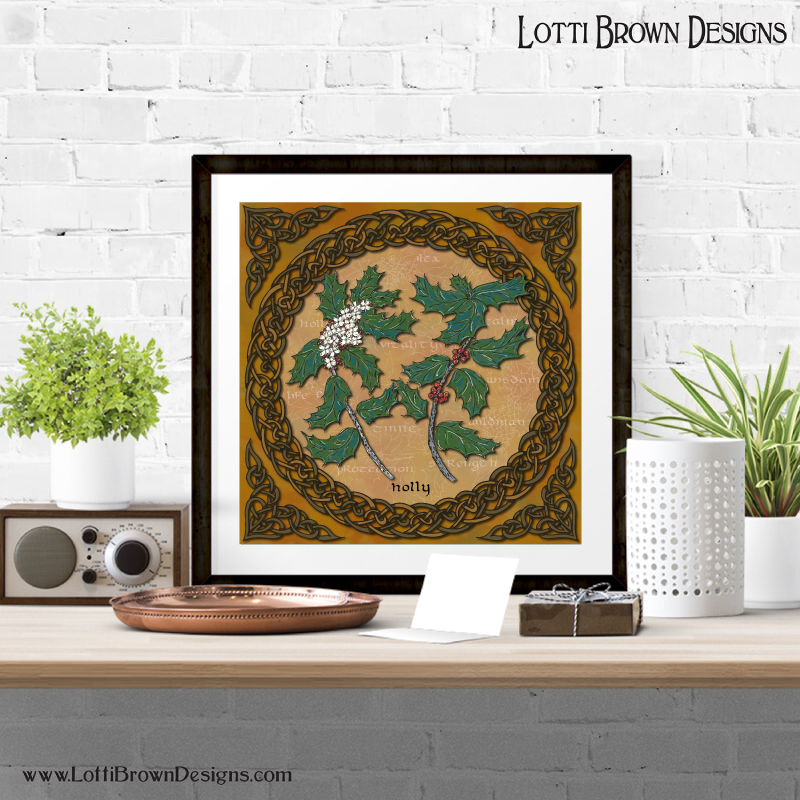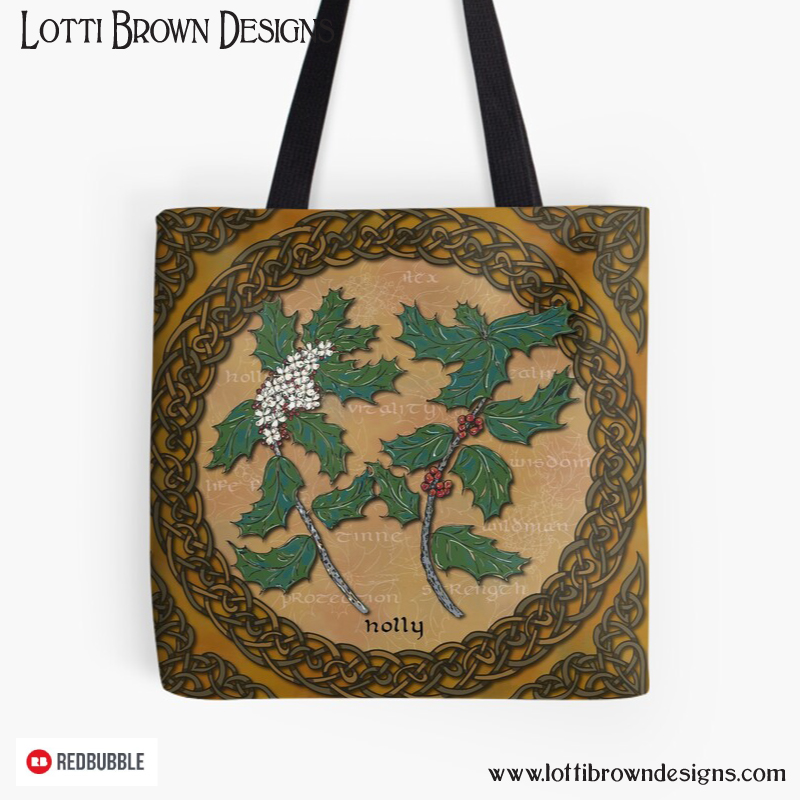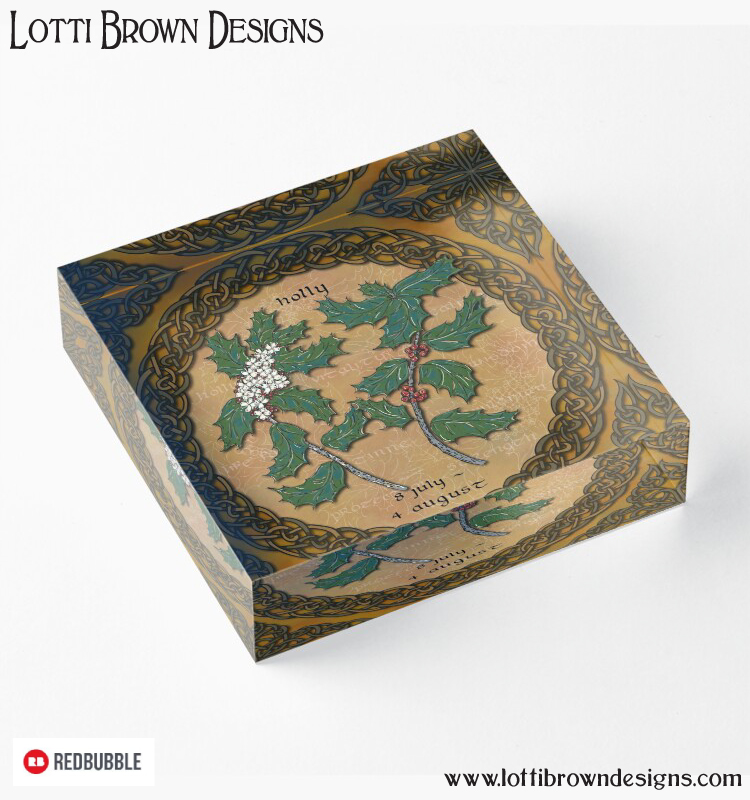*** Digital files - SVG/PNG/DXF/EPS and printables - were retired on 31st December 2025 ***

Holly Tree Symbolism
& Celtic Tree Calendar Holly Art
- Home
- Art - Living Archives
- Celtic Tree Art
- Holly Tree Art
Explore holly tree symbolism, myth and meaning as I share my Celtic Holly Art, part of my Celtic Tree Calendar project...
(Learn more about what the Celtic Tree Calendar is here...)
For many of us in the Western world, the holly is a tree with associations with Christmas – and it’s true that the holly does come to the fore at this time of year, and traditionally it has very important associations with midwinter…
But holly is not just for Christmas, and we’ll see how the holly played an important role in our society at all times of the year.
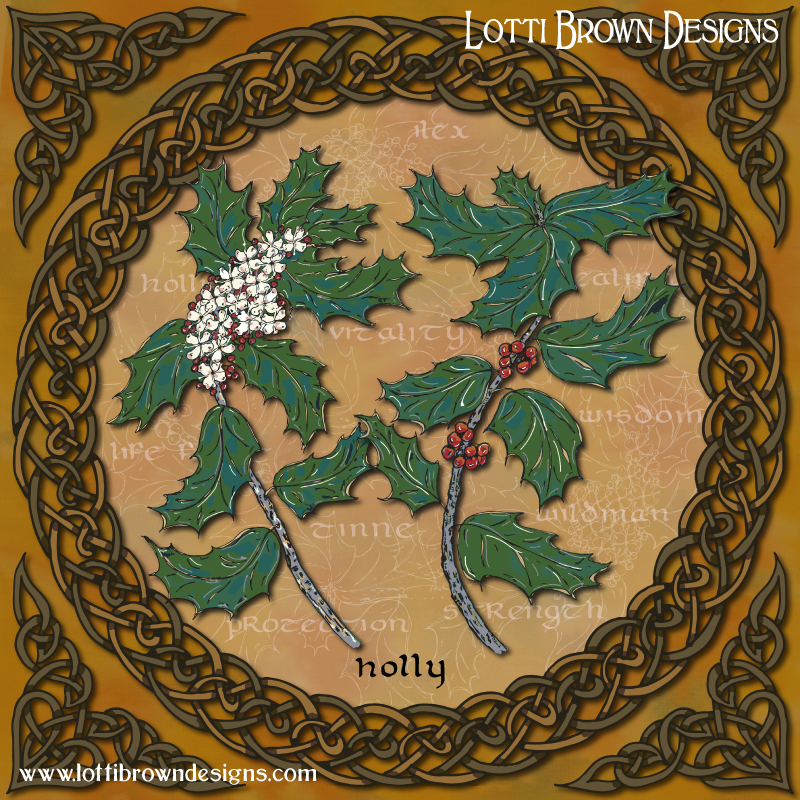 Celtic Holly Art by Lotti Brown
Celtic Holly Art by Lotti BrownCeltic Tree Calendar Holly - July 8th to August 4th
- Latin name: Ilex
- Irish/Gaelic name: Tinne
- Common names: Holly, Holy tree, Hulm tree, Christ’s thorn
- Qualities: strength, protection, vitality, life force, old age, dormancy, healing
- Associations: midwinter, Christmas, Christ, the Holly King, the Wildman, the Green Knight, Saturn/Kronos/Saturnalia/Old Father Time, fire, lightning, the wheel, Taranis, Odin, Thor, masculinity, virility,
Holly Tree Symbolism, Myth & Meaning
The holly tree has long been an important part of our culture and holly tree symbolism and meaning is imbued in some of the traditions and associations that last even to this day, so it's interesting to see where these associations originated from...
 Holly leaves are instantly recognizable
Holly leaves are instantly recognizableA Useful Tree
The Old Irish ‘Brehon’ laws saw holly as a ‘chieftain’ tree – an important tree.
The wood of the holly was widely used for charcoal and chariot/cart wheels, spear-shafts, door handles and sills, walking sticks, and whips.
Holly wood is white and is used as a replacement for ivory (such as for knife handles) and is stained black as a ‘poor man’s ebony’ especially for furniture marquetry.
Holly bark was used in bird lime which was exported from the UK as an insecticide.
And holly makes a strong and protective hedge, while holly leaves can be used to stop mice eating seeds…
Yet, young holly stems were fed to cows to improve the milk and make it taste sweet – and animals including sheep and deer will eat holly leaves in winter whilst little birds feast on the berries.
A Midwinter Tree
The main symbolic importance of holly is in its evergreen nature – in the darkest midwinter days, the holly stays shiny and green and is even lit up with brilliant red berries - the hardy leaves withstanding even the harshest winter weathers.
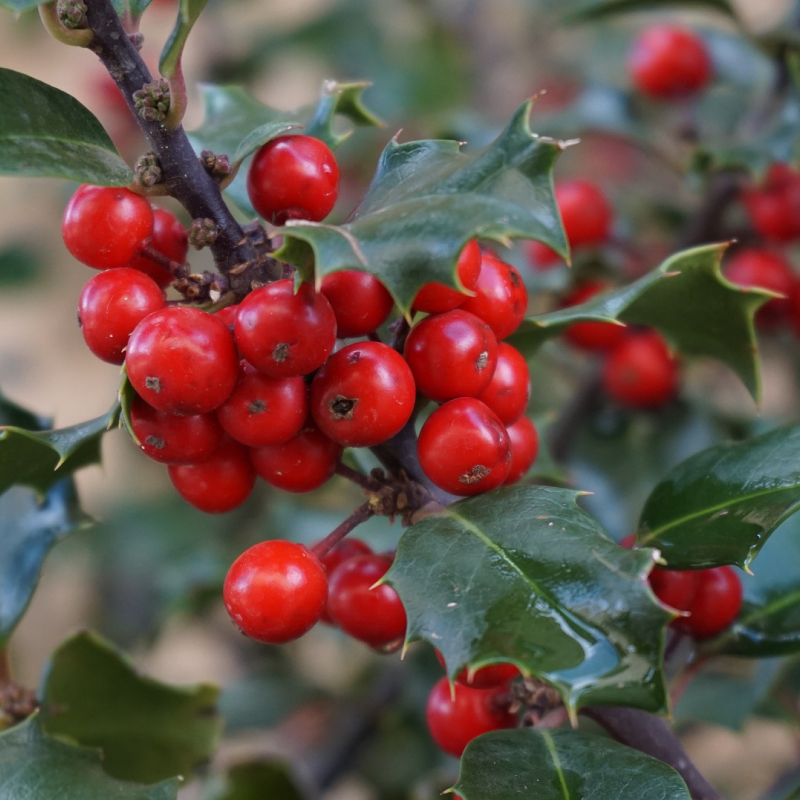 Bright red holly berries
Bright red holly berriesThe power of the holly was seen to be in its life force – its living energy, so strong and vibrant in midwinter. This led to Druids advising people to bring the green foliage inside to decorate their homes and bring that life force inside.
The glossy leaves of the holly also reflected all available light around home and made those darkest days of winter a little lighter and brighter, lifting the mood of the inhabitants of the home.
It was also thought that the foliage would provide shelter to the elves and fairies who could live safely side by side with humans at this special time – with the caveat that the holly foliage should be removed by Imbolc Eve (31st January).
Holly is associated with the Roman feast of Saturnalia, honouring the Roman god Saturn (or his Ancient Greek equivalent, Kronos) – an agricultural god associated with old age and known as ‘Old Father Time’.
Holly wreaths were worn and there was much feasting, merry-making, and gift-giving. Saturnalia was originally celebrated on 17th December for five days, later moving to the winter solstice around 22nd December.
It is believed that these midwinter festivities influenced the form of the Christian celebration of Christ’s birth on 25th December.
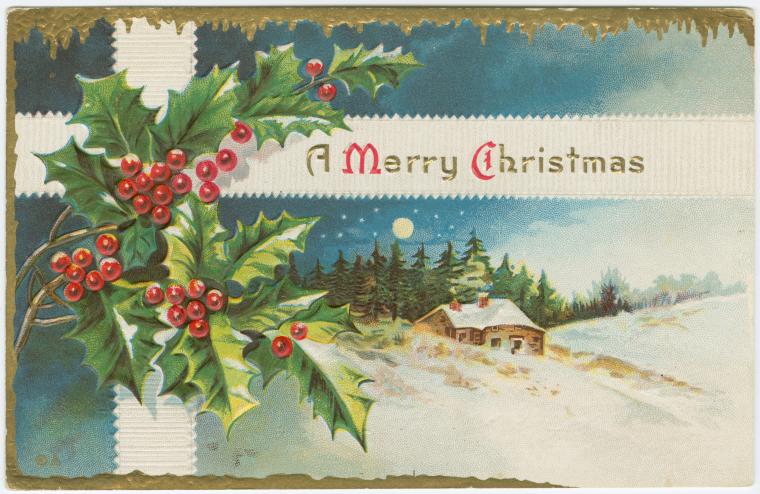 Christmas Holly postcard from 1910 (New York Public Library)
Christmas Holly postcard from 1910 (New York Public Library)Christian stories tell that the holly sprang from Christ’s footsteps and the prickly leaves symbolise the suffering of Christ, and the red berries, his blood. Holly is known as ‘Christ’s Thorn’ in parts of Europe.
It was believed that holly should not be brought into the home before Christmas Eve – and it should be brought in by a man…
But it would be wise to choose equal amounts of smooth-leaved holly (called ‘she-holly’) and prickly-leaved holly (‘he-holly’) to decorate the home, so ensuring an equal role for both husband and wide in the coming year.
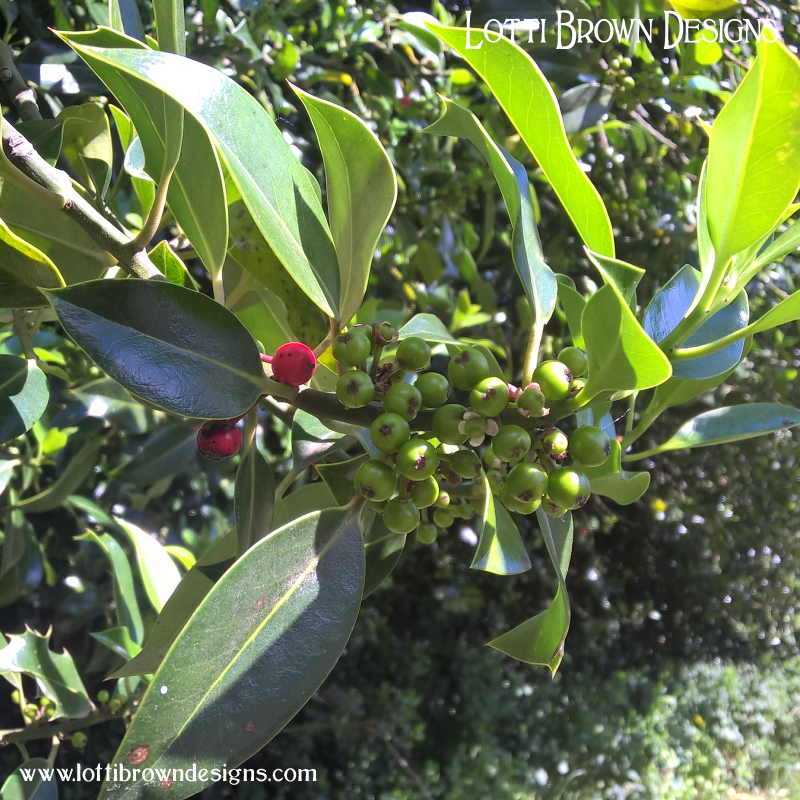 'She-holly' with smooth leaves
'She-holly' with smooth leavesA holly sprig with red berries was used for the Christmas pudding – and a leaf should be kept and burnt under next year’s pudding.
While you shouldn’t bring holly into the house before Christmas Eve, you should also be careful about removing every berry and leaf before Twelfth Night, else bad luck (or goblins!) shall befall you in the coming year…
“Down with the holly, ivie, all,
Wherewith ye drest the Christmas hall,
That so the superstitious find,
Not one least branch there left behind,
For look, how many leaves there be,
Neglected there, maids trust to me,
So many goblins shall you see!”
Robert Herrick
It was seen as lucky, still, to keep a sprig of holly from Christmas to hang it outside the home to protect it in the coming year.
In Brough, Westmorland, a blazing holly branch was carried through the streets with much festivity at Twelfth Night – known as ‘Holly Night’ there.
Meet the Holly King
The midwinter celebrations of holly ties in with legends and traditions of the Holly King.
The Holly King is a medieval symbol but is associated with earlier figures such as the Roman god Saturn and Greek god Kurnos, also known as ‘Old Father Time’ and linked to the wild-men of the Hunt such as the Celtic Cernunnos and other gods of winter.
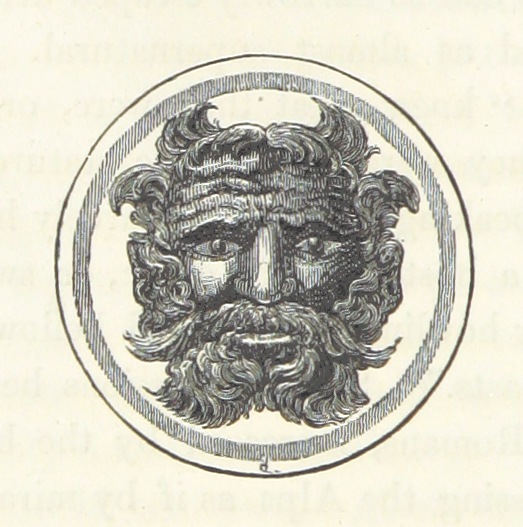 Depiction of Cernunnos (British Library)
Depiction of Cernunnos (British Library)The Holly King is traditionally depicted as a huge wild-man covered in holly branches and foliage and carrying a holly club – and often referred to as the Wildman.
The Holly King is the god or guardian of the darker part of the year, while the Oak King is the god or guardian of the lighter part of the year…
But the switch-over was marked at the solstices – so the Oak King guards the waxing year of fecundity (from midwinter to midsummer) - and hands over the mantel at midsummer to the Holly King who guards the waning year (midsummer to midwinter) – the period of harvest, the dying days of the year and dormancy.
This is why we see the holly tree, which we normally associate with midwinter festivities, celebrated in the very middle of summer, as the solstice is marked as a turning point in the year – the fulcrum point where the natural world starts to wane and die, ready to re-emerge again at the winter solstice.
In medieval times, mummers plays depicted the Oak King and Holly King competing for the hand of the lady goddess – the goddess of the land. The Oak King must ‘win’ at midwinter, to bring the land into growth and fertility – and equally, the Holly King must win at midsummer, to take the land into harvest and old age (the ‘dying days’ of summer) so that the cycle of life can begin again anew the following year.
Courtly tales of King Arthur also follow the theme…
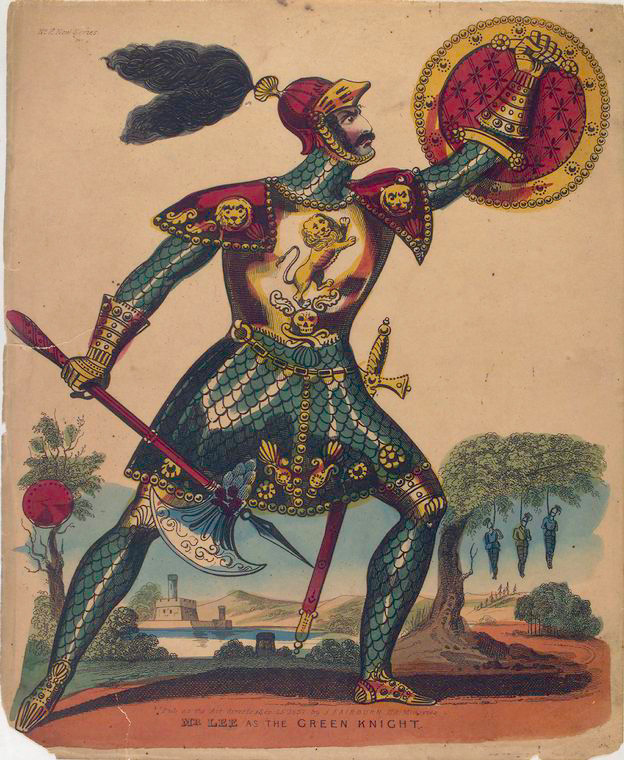 Depiction of the Green Knight, 1837, Billy Rose Theatre Collection (New York Public Library)
Depiction of the Green Knight, 1837, Billy Rose Theatre Collection (New York Public Library)In the tale of Gawain and the Green Knight, we see the Green Knight, huge, green, and terrible, covered with foliage and with a crown of holly, representing the Holly King – and Gawain, with a rod of oak, given the task of defeating the Holly King/Green Knight.
Through the Holly King, the holly is associated with themes of old age and sacrifice, as well as being celebrated as the guardian of the sacred life force through these darkest winter months.
Tree of Fire
The Gaelic word for holly is ‘Tinne’, which means ‘molten metal’ or ‘ingot’ and derives from the Old Gaelic ‘teine’ meaning ‘fire’.
In Celtic legend, the god Oengus calls holly ‘smiur guaile’ – ‘fires of coal’ – while the Celtic hero Cuchulainn calls it ‘a third of weapons, an iron bar’. Holly is strongly linked to fire and smith craft…
Holly is one of the hottest-burning trees – so it was used by Druids for their solstice fires, as well as being used for blacksmiths’ fires, especially when forging swords, axe-heads, weapons, and other important tools.
Holly is thus linked to the Celtic smith god, Govannon (Welsh) or Goibniu (Irish) – and also the Anglo-Saxon smith god, Weyland. Govannon/Goibniu is said to possess the mead/ale of eternal life (linking back to the life-force of the holly) – and he’s associated with skills, strength and endurance.
The custom of first-footing in Scotland and the North of England, when a man carries coal and greenery (holly) over the threshold at New Year may be linked to these themes, too.
 Holly tree
Holly treeThe Lightning Tree
Holly is associated with the Celtic god of thunder, Taranis.
Taranis was a war-god, so the link to the making of weapons by smithies over holly fires brings holly in there.
The symbol of Taranis is the wheel – so holly is linked through its importance in the turning of the wheel of the year, as well as holly being used in the making of chariot wheels, alongside oak wood.
In the ‘Ulster Cycle’ or ‘Irish Red Branch’, Morainn mac Moin (the chief druid of Ulster) says that holly is ‘Train roith’ – a ‘third of a wheel’.
Holly is also linked to the Scandinavian war gods Thor and Odin. Odin’s magical spear, Gugnir, was made of holly – and Thor was the Viking god of thunder.
It’s said that lightning would never strike holly – and science shows that the spiky leaves may actually act like tiny lightning conductors.
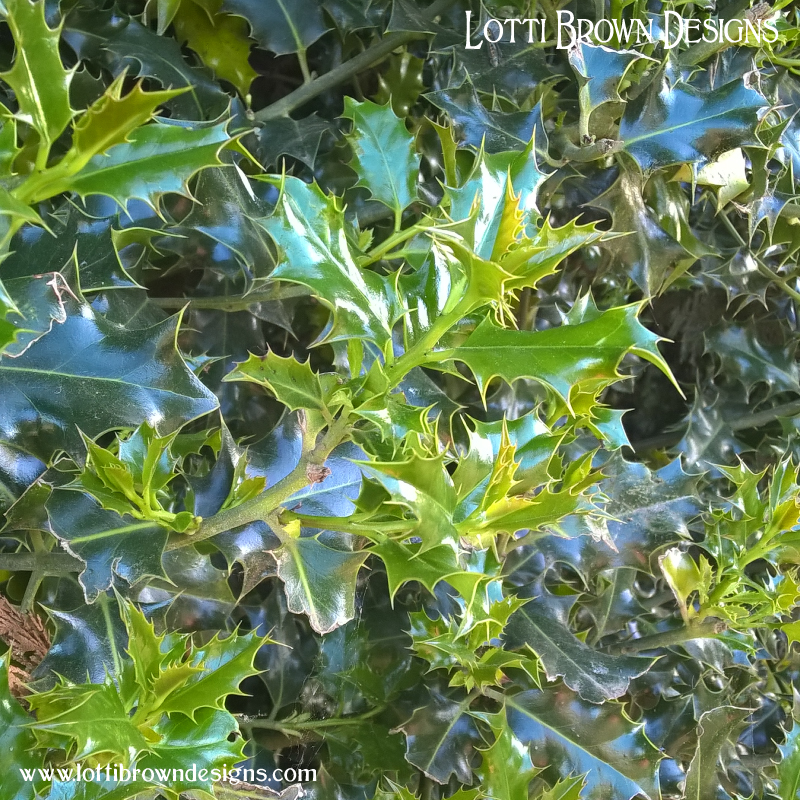 Young holly leaves
Young holly leavesIt was believed safe to shelter under a holly tree in a thunderstorm and lone walkers were permitted to cut a holly stick from the hedgerow for protection, and it was seen as advisable to carry a holly twig in your pocket.
In Roman times, the writer Pliny the Elder recommends that holly planted near a home protects it from lightning as well as witchcraft!
The Lucky Tree
Holly was believed to be a protector, especially from witchcraft. The red berries were thought to be strongly protective against witches.
Berryless holly would be rejected, while luck decreased with each berry that was allowed to drop from your midwinter decorations.
It is thought that a bumper berry year would precede a harsh winter as nature provides for the birds – but commonly, a holly tree will crop only sparsely, if at all, the year following a heavy berry crop year…
So in times of berry scarcity, the Christmas foliage was created with holly leaves and ivy berries that were dyed red so that the protective Christmas wreath could be hung at the door.
It’s traditionally seen as very lucky to have a holly bush or tree growing outside your home for protection (particularly if it’s self-seeded there) – so people would plant holly hedges around cottages and build door sills and handles with the wood of holly, especially in the east of England.
Horses would be given collars of holly leaves to wear for protection – and throwing holly leaves towards wild animals was said to calm them.
And newborns were sprinkled with holly-water for protection and to give a strong life-force for the new baby.
But be warned: never cut a holly without asking permission from the tree’s spirit first..!
 Holly bush
Holly bushA Tree for Men
The holly tree is primarily seen as a male tree - as already noted, only a man should bring holly into the home at Christmas…
While it was also thought that men carrying holly leaves would be sexually attractive to women!
Holly hung over the bed was believed to enhance a man’s sexual energy and vital life force and to rekindle desires between married couples!
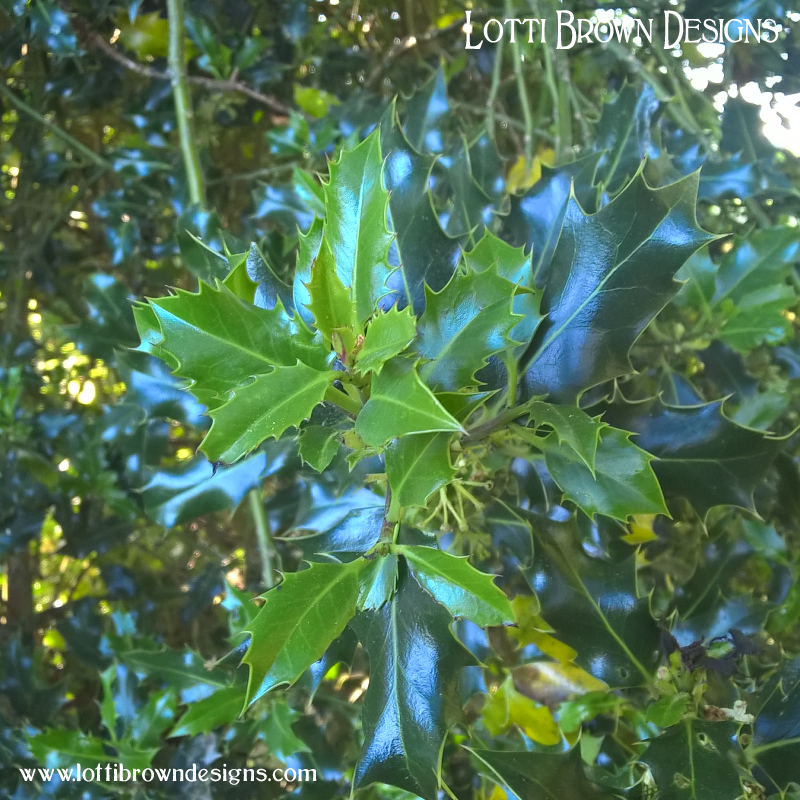 Holly leaves
Holly leavesThe Dreaming & Divination Tree
Holly is said to be the tree of dreams and was used to ease insomnia and to induce pleasant dreams as well as to make your dreams come true (surely no-one really wants all their dreams to come true – that would be terrifying!).
Sleeping with a leaf, twig, or bark of holly under your pillow could help you dream of the future or gain prophetic wisdom…
In the north of England, in order to dream of her future husband, a young girl would, at midnight on a Friday night, gather 9 smooth-leaved ‘she-holly’ leaves and with 9 knots, tie them into a handkerchief, and then sleep with them, that night, under her pillow.
In using holly to dream, it’s said that you may instead access the darker parts of your subconscious – those prickly aspects that you maybe don’t want to acknowledge but you need the strength of the holly to work through.
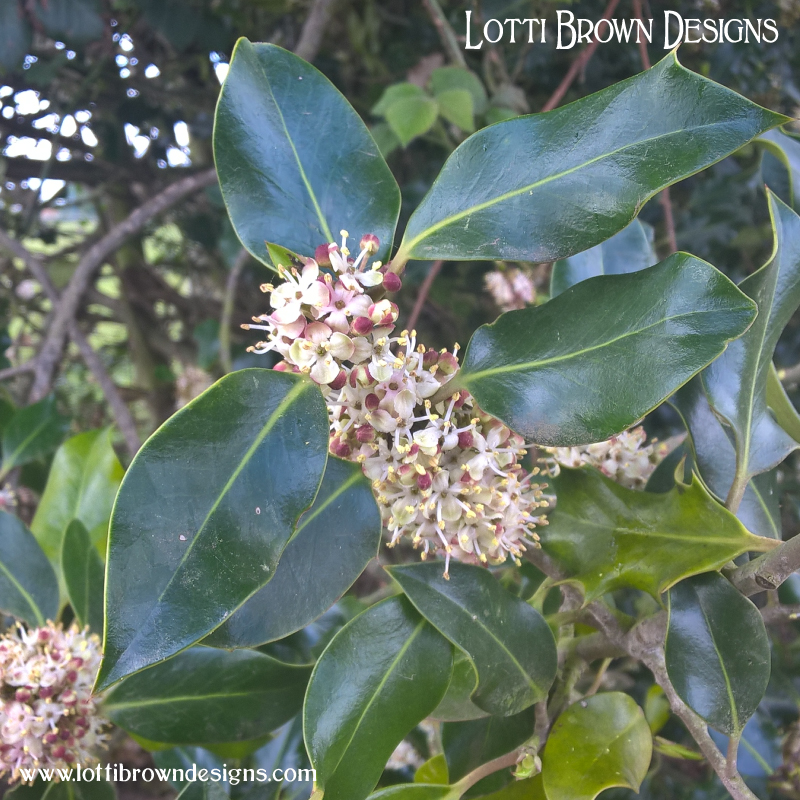 She-holly with flowers
She-holly with flowersThe Healing Holly Tree
Holly has been used medicinally as a tonic herb to help lower fevers, induce sweating, and rid the body of toxins.
Children were sometimes passed through a holly tree in a ‘split- tree cure’ – the trunk of the tree was vertically split in two and the ailing child was passed naked through the split. The tree was bound up again and as the tree healed, it was hoped the child too would heal and grow strong and healthy.
A holly leaf tea was used for coughs, bronchial complaints, flu, fever, and pneumonia, as well as for rheumatism. The tea could also be drunk to calm anger and jealous emotions.
In his book, ‘The Complete Herbal’, Culpeper writes that a poultice of holly leaves could be used for dislocated and broken bones.
 Holly boughs
Holly boughsIn some parts, chilblains were thrashed with a spray of holly to ‘let the bad blood out’ – and corns could be cured with an application of holly leaves, soaked in vinegar, and left on for a day and a night.
A species of holly is the herb used in yerba mate/mate tea – and the aptly-named holly ‘Ilex vomitoria’ was used for the emetic ‘black drink’ used in Native American rituals.
Holly berries were used as an animal medicine but are seen as poisonous to humans. They were sometimes used to induce vomiting.
Bach Flower Remedies use holly to create feelings of good-will and kind-heartedness – especially helpful for feelings of suspicion, jealousy or revenge.
Holly Tree Symbolism & Meaning
Summary of holly tree symbolism themes...
 My holly drawings
My holly drawingsThe holly is a tree of strength and protection.
It’s a tree that contains a vital life force to take us through the darkest days with light, colour, and tenacity.
It’s a tree of wisdom and healing, of age and rebirth.
It’s a symbol of nature – the ‘wildman’ (and perhaps woman) in all of us – linking midsummer to midwinter – and linking our darkest hours to our times of plenty, giving us life and strength to carry on.
 Meaning for Holly tree, hand-written in calligraphy
Meaning for Holly tree, hand-written in calligraphyCeltic Holly Tree Art
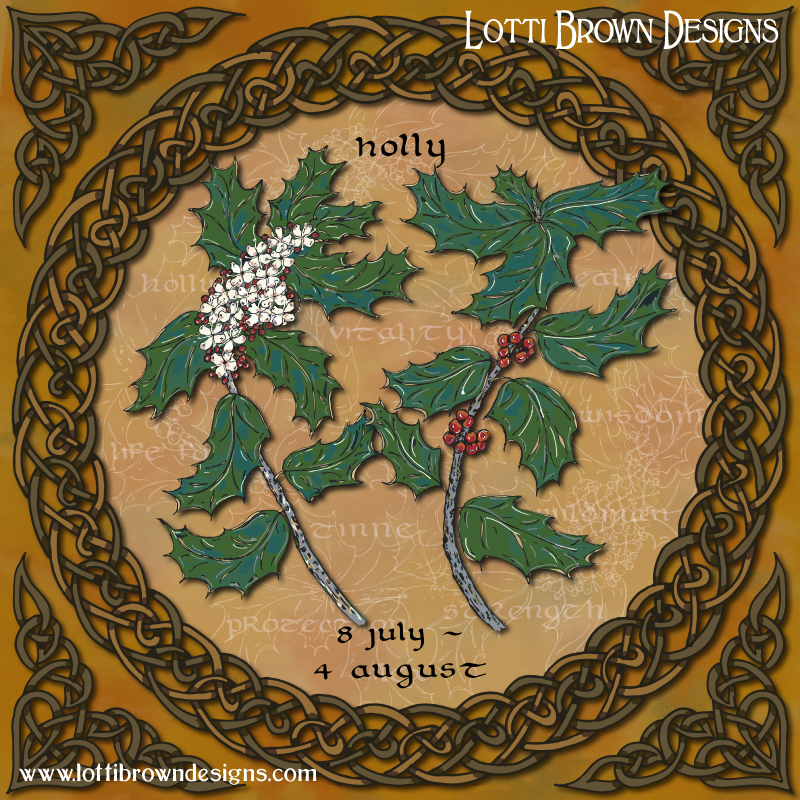 My Celtic Tree Calendar art for Holly - 8th July to 4th August
My Celtic Tree Calendar art for Holly - 8th July to 4th AugustI created two versions of my Celtic Tree Calendar Holly art:
- A dated version with the Celtic Tree Calendar dates for the month of Holly (8 July - 4 August) (see that just above or at the link just below)
- And one that's undated (see top of the page or at the link just below)
You can buy both versions from my Redbubble store with worldwide delivery from your closest manufacturing centre (and customs refunds if you're charged) - art prints, T-shirts and sweatshirts, throw pillows and blankets, shower curtains, phone cases, mugs, notebooks, scarves, and lots more...
Here's just a small selection below - or browse everything at the links for each version (also below)...
Browse all products for both versions using the links just below...
Explore my other Celtic Tree calendar artworks and tree meanings here...
Find out more about the Celtic Tree Calendar, what it is and how it was created, here...
See all of my earlier art here...
Discover more British nature folklore in my Folklore Hub here...
Explore my current art collections here!
Further Reading
- Tree Wisdom – book by J. M. Paterson
- Celtic Tree Magic – book by D. Forest
- Discovering the Folklore of Plants – book by M. Baker
- RHS Encyclopedia of Herbs – book by D. Bown
Shall we stay in touch..?
Each month, I share stories from my own nature journal, new art from my studio, and simple seasonal inspiration to help you feel more connected with the turning year...
Recent Articles
-
British Nature Art Prints - Bird & Wildlife Wall Art to Buy (UK)
Jan 02, 26 06:48 AM
Shop British bird and wildlife art prints by Lotti Brown. Hand-drawn, archival giclée prints with UK shipping via Folksy. Perfect gifts for nature lovers. -
December Berries Folklore in Britain - Rosehips, Holly and Haws
Dec 24, 25 04:35 AM
Explore December berries folklore in Britain - rosehips, haws, holly, ivy and sloes - with seasonal nature notes, birdlife, and quiet winter magic. -
Birch Tree Symbolism, Myth, and Folklore
Dec 23, 25 04:19 AM
Explore birch tree symbolism, myth, meaning and folklore as part of my Celtic Tree Calendar art project...
Shop My Art Prints
Follow me:
Share this page:

